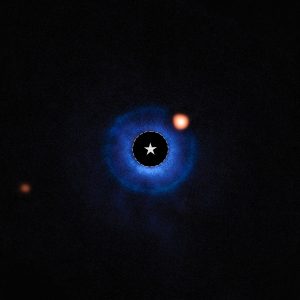
NASA’s Webb telescope makes history by directly imaging a Saturn-sized planet orbiting a young star 110 light-years from Earth.
In a historic achievement for space exploration, NASA‘s James Webb Space Telescope (JWST) has directly discovered a previously unknown exoplanet—marking the first time this powerful instrument has found a brand-new alien world on its own. The newly detected planet, named TWA 7b, is located about 110 light-years from Earth in the southern constellation Antlia. It orbits a very young star known as TWA 7, which is only around six million years old. This discovery not only pushes the boundaries of planetary science but also opens a new era in the use of infrared space telescopes to identify distant worlds directly, rather than through indirect methods.

Unlike many of the nearly 5,000 exoplanets previously discovered using methods like transit photometry or radial velocity, TWA 7b was found through direct imaging—a far more difficult technique. It requires advanced instruments to isolate the faint light of a planet from the overwhelming glare of its parent star. Webb’s advanced mid-infrared instrumentation and coronagraph—a device used to block the starlight—made this possible. This marks a turning point for the scientific community, as it demonstrates that JWST can be used not only to study known exoplanets but to actively discover new ones as well.
TWA 7b is a gas giant, roughly the mass of Saturn, which makes it the lightest exoplanet ever to be directly imaged. Previous direct imaging detections were mostly of massive, Jupiter-sized or larger planets orbiting very far from their host stars. TWA 7b, however, orbits its star at a distance of approximately 52 astronomical units (AU)—52 times the distance between the Earth and the Sun—placing it within a sparsely populated gap in a multi-ringed debris disk surrounding the star. This kind of positioning suggests that the planet may play a role in shaping the structure of the disk itself, a phenomenon predicted by planetary formation models but rarely seen with such clarity.
The host star, TWA 7, is part of the TW Hydrae association—a group of young stars that offer ideal laboratories for studying the early stages of planetary development. Due to the system’s favorable angle, the JWST team could observe the disk nearly face-on, maximizing their ability to spot features within it. By identifying TWA 7b, scientists were able to confirm that at least some gaps in debris disks are indeed the result of forming planets carving out their orbits—a theory that has existed for years but lacked direct observational evidence.
This discovery has wide-ranging implications for the future of exoplanet research. First, it proves that JWST can directly detect planets with lower masses than previously imaged, paving the way for future discoveries of even smaller, possibly Earth-like worlds. Second, it validates observational strategies that target young stars with visible debris disks as prime candidates for new planet discoveries. Third, it provides strong support for upcoming missions like NASA’s Habitable Worlds Observatory, which will rely on similar imaging techniques to find potentially habitable exoplanets in the coming decades.
Scientists who led the discovery emphasized the groundbreaking nature of the finding. The team used the Mid-Infrared Instrument (MIRI) on board JWST, equipped with a coronagraph developed by French researchers. It allowed them to suppress the star’s light while picking up the thermal glow of the much cooler planet. The planet’s youth also played a role—it is still hot from its recent formation, making it more visible in infrared wavelengths.
The image captured shows the planet faintly glowing next to a dark ring where the coronagraph blocked the star. The planet’s spectrum confirms its approximate mass and temperature, and ongoing observations are expected to help measure its atmosphere and composition. Scientists believe the planet is still cooling, and its atmosphere may contain water vapor, methane, or even more complex molecules—details that will become clearer with future spectroscopic studies.
Though the discovery of TWA 7b is remarkable in its own right, it also demonstrates JWST’s powerful capability to conduct deep imaging studies and uncover phenomena beyond what its predecessor, the Hubble Space Telescope, could achieve. While Hubble made significant contributions to exoplanet science, its abilities in the infrared spectrum were limited. JWST, on the other hand, was specifically designed to operate in the mid- and near-infrared range, making it ideally suited to observing the thermal signatures of young, distant worlds.
This achievement also marks a significant step in understanding how planetary systems evolve. By studying the interaction between TWA 7b and its host star’s debris disk, scientists can better model how gas giants form, migrate, and influence their surroundings. These insights could eventually be applied to understanding our own solar system’s formation, particularly the early roles of Jupiter and Saturn.
The discovery also signals that the techniques used here—targeting young, bright stars with visible dust disks—are highly effective and should be expanded. Future observations are expected to scan similar systems in nearby star-forming regions, with hopes of finding more young planets, some potentially smaller or closer to their host stars.
In conclusion, the James Webb Space Telescope’s discovery of TWA 7b marks a milestone not only for the telescope but for the entire field of exoplanetary science. It confirms that the telescope is capable of directly imaging relatively low-mass planets, mapping their positions, and even analyzing their atmospheres. TWA 7b is not just another distant world; it’s the first of what could be many discoveries that redefine our understanding of planetary systems and the potential for life beyond Earth.
SOURCE : hindustantimes







